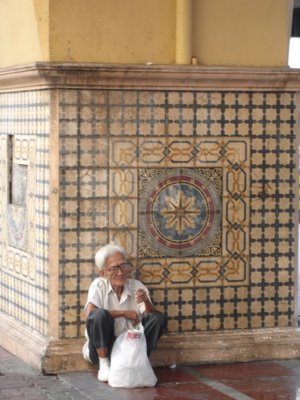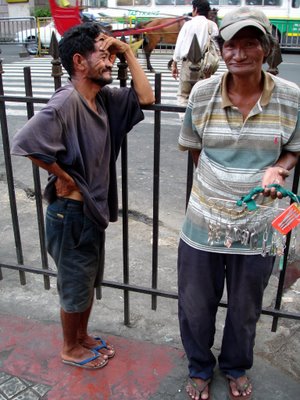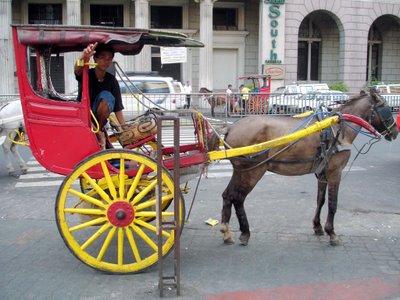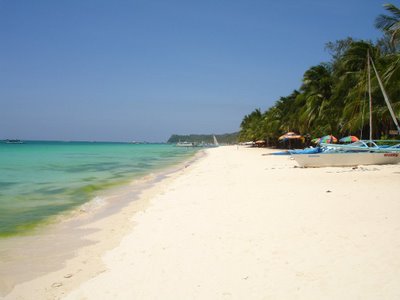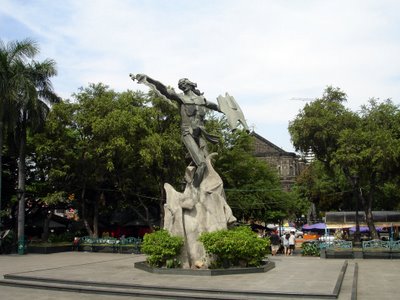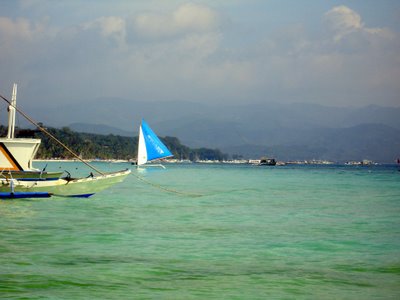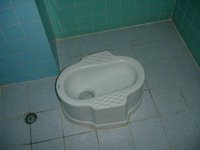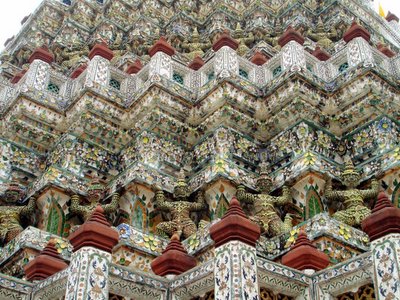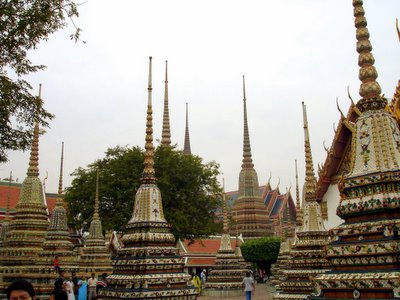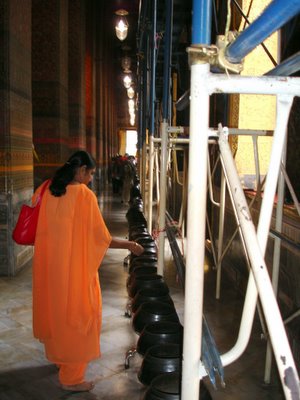
Situated next to the Grand Palace about 15 minutes' walk to the southwest from Khao San Road, Wat Phra Kaew is the most famous temples in Thailand. The weather was cloudy and hazy today, so these pictures are even more insufficient that they normally would be to convey the enormity of this place and the brilliant designs and colors this place has to offer.
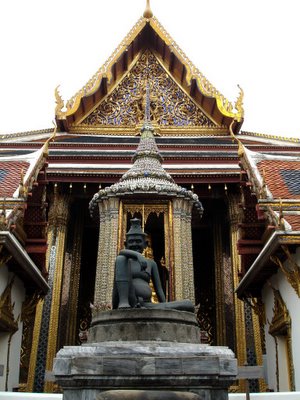
The grounds are really a maze of statues, chedi (stupas), small shrines, and five larger structures, all surrounded by an ornate outer wall. The Upper Terrace holds four of the large structures, as the brochure says "a reliquary in the shape of a golden chedi; the Mondop, a repository for Buddhist sacred scriptures inscribed on palm leaves, contained within a beautiful mother-of-pearl inlaid cabinet; a miniature Angkor Wat crafted by the order of King Mongkut (Rama IV); and the Royal Pantheon in which statues of past sovereigns of the ruling Chakri dynasty are enshrined."
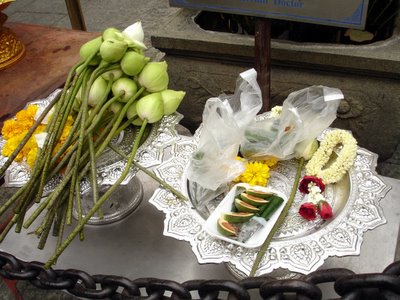
Offerings for sale. For a nominal fee, you can dip one of these lotus blossoms in some water and bonk yourself on the head.

There are a lot of these huge guards, of varying color, two at each gate. I come up to about mid-calf on this guy, I guess.
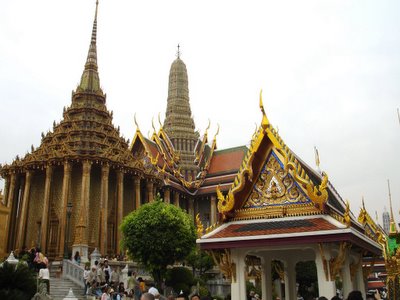
The two larger structures are the Phra Mondop (left) and the Royal Pantheon.
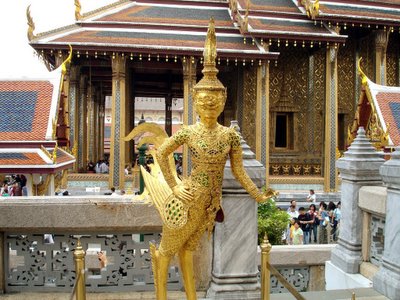
The Royal Pantheon is surrounded by all kinds of statues of mythological beings.
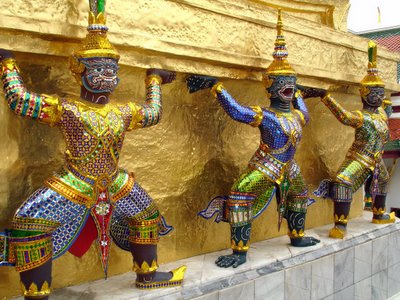
These guys are holding up a golded chedi. Lots of tourists were taking pictures of each others in front of this doing the same pose as the statues.

The entire inside surface of the outer wall of the complex is covered in one big mural telling the Thai version of the life of Buddha.

These vulture-like statues surround the fifth and most important structure on the site, the Royal Monastery of the Emerald Buddha. You are not allowed to take pictures inside, but I snapped the following photo through the crowded doorway.
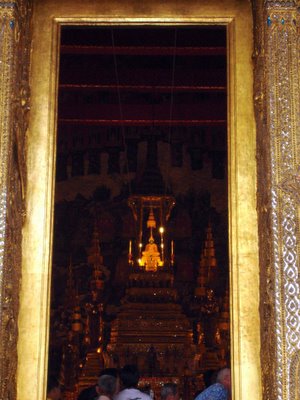
The brochure says of this site, "North of the royal residence and linked by a connecting gateway lies the Royal Monastery of the Emerald Buddha, one of the most venerated sites in Thailand where people convene to pay respect to the Lord Buddha and His Teachings. The Emerald Buddha is enshrined on a golden traditional Thai-style throne made of gilded-carved wood, known as a Busabok, in the ordination hall of the royal monastery. The sacred image is clad with one of the three seasonal costumes (summer, rainy season, and winter). The costumes are changed three times a year in a ceremony presided over by His Majesty the King.
The Emerald Buddha is in fact carved from a block of green jade and was first discovered in 1434 in a stupa in Chiang Rai (far north Thailand). At that time the image was covered with plaster and was thought to be an ordinary Buddha image. Later, however, the abbot who had found the image noticed that the plaster on the nose had flaked off, revealing the green stone. The abbot initially thought that the stone was emerald and thus the legend of the Emerald Buddha image began.
The image was later taken to Lampang where it remained until King Tilok of Lannathai moved it to Chiang Mai, his capital, where it was fittingly enshrined. In 1552 an interruption occurred in the Lannathai line of succession. King Chaichettha of Luang Prabang, who was the son of a Chiang Mai princess and a Laotian king was invited to fill the gap. However, after a relatively short reign he returned to Laos to succeed his father's throne, taking with him the Emerald Buddha. The image remained in Laos for 226 years until 1779 when a Thai army under the command of Chao Phraya Chakri, who later became King Rama I, captured Vientiane, the Laotian capital, and the image was brought back to Thailand. When King Rama I had built the city of Bangkok, the Emerald Buddha was housed within the Royal Monastery with due pomp and ceremony.
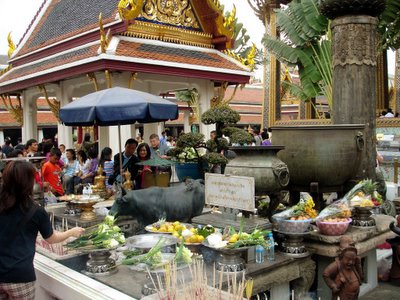
Outside the front of the monastery there were a lot of offerings for sale, candles and incense being burned, and people praying.
Wat Phra Kaew is on the same grounds as the Grand Palace, which also has a great deal of interesting Thai architecture, but as most of it was under roof restoration, I didn't get any outstanding pictures there.


